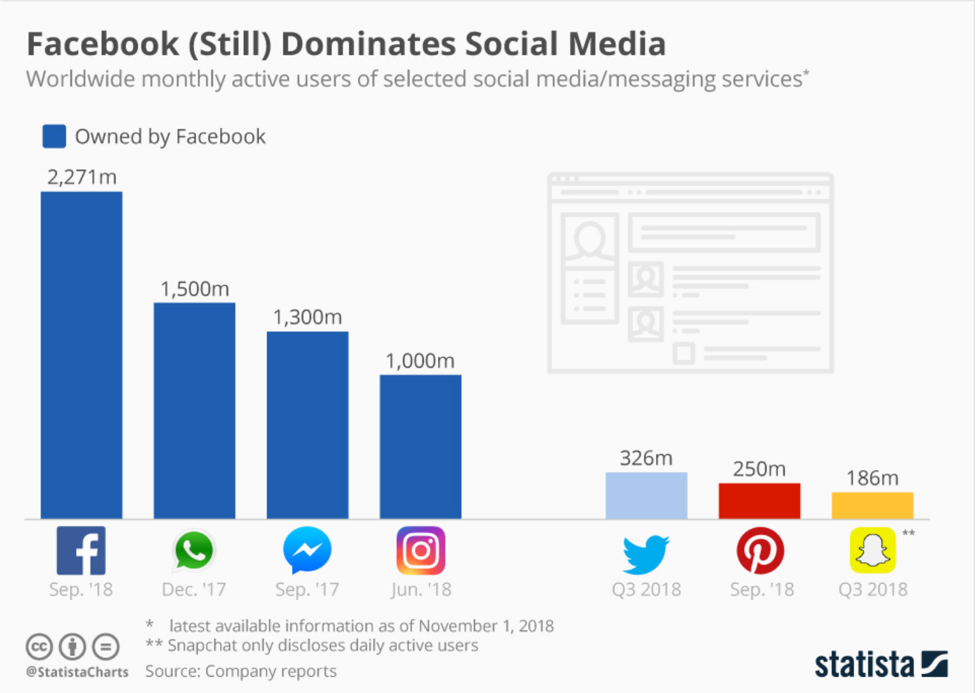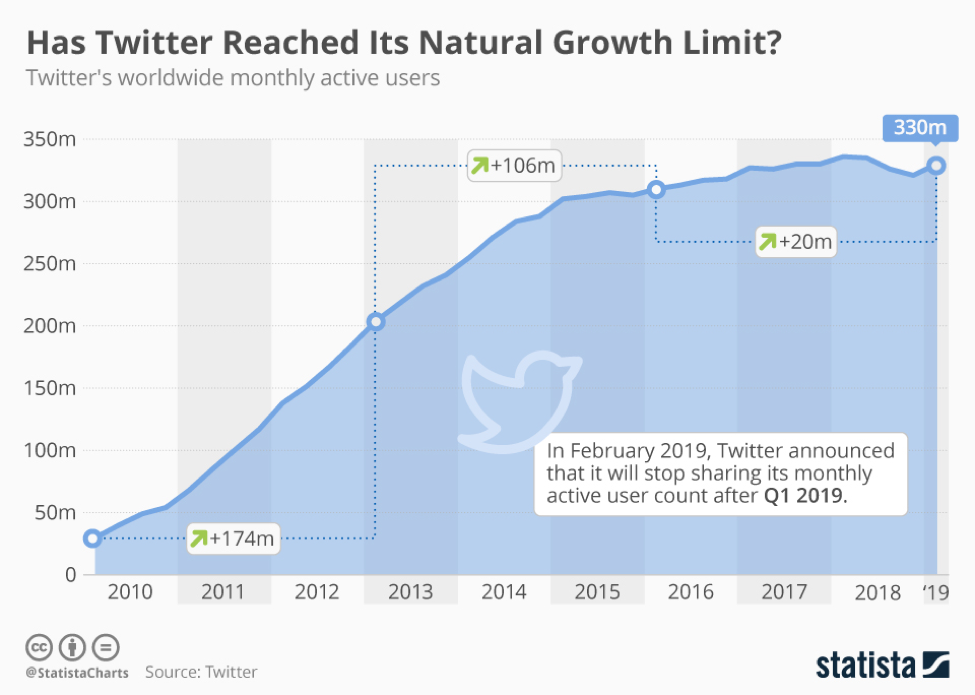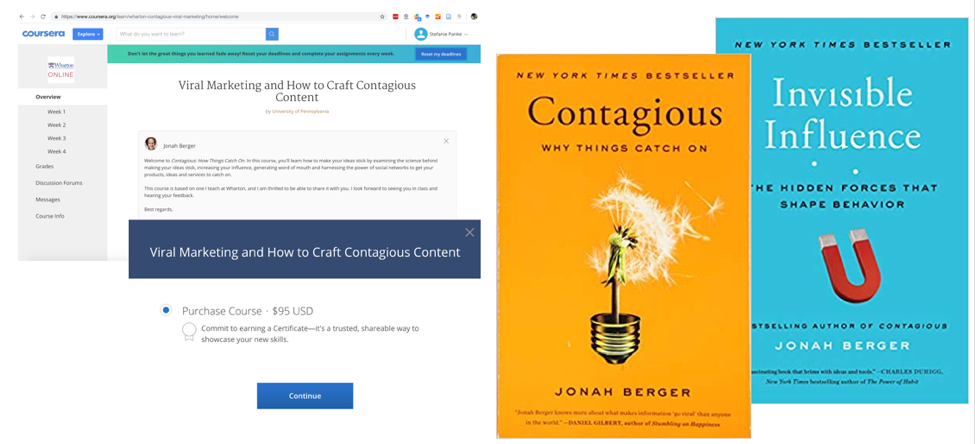Social Media: Channeling the Channels

In this session of the social media class we discussed how to leverage different social media applications and networks, how to monitor reach in social media, and how to better understand the conditions for viral content with the model STEPPS.
Channels
We looked in more detail at different social media tools, in particular the popular networks Facebook and Twitter, as well as messaging apps (SnapChat, WhatsApp) and Instagram. We reviewed statistical background information and details about each tool.
Throughout the class sessions I presented different data sets that were sourced from ‘statista’. Statista is in an interesting example of a German startup: An online portal for statistics, the portal collects and combines data from different sources and makes datasets and data dossiers available in English, French, German and Spanish. The company is located in Hamburg and has 600 employees and clients around the world – one of which is UNC Chapel Hill. It’s a good business idea, but the reason why I really like statista is that they offer creative commons infographics, some of which are included in this post.

- Facebook is a social networking service that was created by Mark Zuckerberg in 2004 and opened to the public in 2006. Facebook is now, by a very wide margin, the biggest social network worldwide. As of the fourth quarter of 2018, Facebook had more than 3 billion global monthly active users
- Snapchat is a mobile photo messaging and multimedia sharing app which was released in 2011. The app was initially launched to share impermanent pictures via private message ‘snaps’ that can be viewed for a user-specified length of time. Despite its origins as a photo app, video has become an important feature of Snapchat. During the fourth quarter of 2018, Snapchat reported 186 million daily active users worldwide. It ranks as the most popular social media siteamong teenagers and young adults in the United States.
- WhatsApp is a cross-platform mobile instant messaging service. As of January 2017, the mobile messenger has more than 2 billion monthly active users worldwideand ranks as one of the most popular social platforms globally. Facebook acquired WhatsApp for $19 Billion.
- Instagram is a photo-sharing social networking appthat enables users to take pictures and edit them with a selection of digital filters. Instagram also started to offer video sharing and Instagram Stories, a feature competing with Snapchat’s Stories. The service was initially released as an iOS app but is now also available for other mobile systems as well as online. As of June 2018, the social network reported more than 1 billion monthly active users worldwide and the social media network’s daily active users stood at 500 million.
- Twitter enables users to send 280-character messages (tweets). Twitter currently ranks as one of the leading social networks worldwidebased on active users. As of the fourth quarter of 2018, Twitter had 321 million monthly active users. During the same period, the number of monetizable daily active Twitter users worldwide stood at 126 million. Registered users can read and post tweets as well as follow other users via update feed.

Update: I love it when articles receive substantive feedback, especially when it is about material that I use in teaching, as is the case here. Johann, an author from the consumer portal ‘thegoodstate’ reached out to let us know that he and his colleague Robert have put together a more updated & more encompassing piece on the latest Facebook metrics.
In fact, they have created a hole series with Facebook consumer data:
Managing Social Media
I gave the students insights into how I manage and monitor social media channels at AACE. I showed them how I use Google Analytics and Google Data Studio to monitor the blog AACE Review, and how organizations such as AACE can use Facebook insights to learn more about how to share their content effectively in global networks. I used the post ‘Of Monsters and Tech’ as an example to illustrate that engaging content, connections to tools, companies or organizations, hashtags and personal recommendations all play a role in making postings popular.


STEPPS
Lastly, I introduced the model STEPPS, a model by Jonah Berger that he discusses in the MOOC ‘Viral Marketing and How to Craft Contagious Content’. Berger sets out to explain what makes some messages tastier than others. STEPPS stands for Social Currency, Triggers, Emotion, Public, Practical Value, and Stories. Each of these dimensions is a psychological driver of what people talk and share, and it helps explain why all sorts of products and ideas catch on – here is a summary of the Berger lecture videos, though I encourage you to watch the original, as he (somewhat unsurprising) uses many great stories that make these principles memorable.

- Social Currency: Having access to something that not everyone else has makes us feel smart and in the know, it gives us social currency. Just like the car we drive and the clothes we wear, the things we say and the things we share affect how other people see us. We are likely to share something that makes us look knowledgeable. The more special we feel, the more something makes us look good, the more likely we are to pass it on.
- Triggers: It’s not just whether we like something or not that influences our decision to buy or share, it’s whether we’re thinking about it or not. This means that you need to understand the audience if you want to create viral messages: When do you want your target audience to think about your idea? What is in the environment they are in at that time, and how you can link your message to that trigger? “More triggered, more top of mind, more tip of tongue”, as Berger states it.
- Emotions: When we care, the more we care, the more likely we are to share. The emotion does not necessarily need to be positive to create emotional arousal. Anger and anxiety actually increase sharing, as does happy, funny content. Sad stories are less likely to be shared. It’s not enough to make content that has functional information in it, to reach broad audiences content creators have to find an emotional core.
- Public: If something is built to show, it’s built to grow. The easier it is to see, the easier it is to imitate. We need to make hidden things more public, for example by telling your audience ‘1000’ people have already shared this. Think about how to make the unobservable aspects of your idea more observable. Too often what we do is not easy for others to see.
- Practical Value: People don’t just share things that make them look good, they share things that help others and make others better off. How we frame that information, how we make it seem even more useful, will drive people to take action.
- Stories: How can we use stories to get people to share our ideas? Good marketing stories are like a Trojan horse. They act as vessels or carriers of information. When parents put their kids to bed at night, they do not tell bedtime facts, they tell bedtime stories. Stories are the currency of the conversation. Good stories carry ideas along with it. If you want to get your idea to travel, think about how you can build a story that carries it as part and parcel of the message.
Review
We concluded the session with a quick review of the semester:
Learning with Social Media – what to remember:
The success of Social Media is based on social influence – informative and normative. Social media can be a medium for learning and educational content. This happens through both organizational and individual initiatives. Examples: NASA space missions, and WW2 on Twitter. Read the full post.
Fake News – what to remember:
Artificial intelligence and bots play a growing role in spreading fake news, for example AI services such as ‘This Person Does Not Exist’. However, us, humans, are a deciding factor in the spread information and disinformation. Check before you share: (1) Any previous fact checks, (2) upstream to the source, (3) Read laterally about reputation (4) Circle back. Read the full post.
When Messages Backfire – what to remember:
The SUCCES framework explains why we remember ideas. However, just because we remember a message does not mean it has the intended effect. At least two problems can occur: (1) Discrimination because of gender, race, age, etc. (2) Adverse effects based on social influence. Read the full post.

Hashim Ilyas
November 26, 2019 at 7:54 am
I was asked about this channeling in social media from my teacher, after reading this post now I have an even better idea to use in the future. Thanks for the share.
Stefanie Panke
November 26, 2019 at 9:24 am
Glad to hear this was useful. I will post more about social media, well-being and learning next year, so stay tuned!